Ranked 8th for best states to launch a business in, 5th for fastest start-up growth, and 2nd for business survival rates, starting a business in Minnesota is an excellent choice for entrepreneurs.
But there’s more to life than business!
The North Star state also boasts an outstanding work-life balance with over 10,000 lakes and 17.4 million acres of indigenous forests to enjoy outdoor activities, in addition to excellent healthcare and education systems.
Impressive, right?
But to start a business in Minnesota, you’ll need more than positive statistics!
To ensure your business’s success, you need a viable idea, a great name, a perfect location, a business structure, a mix of licenses and permits, and perhaps employees!
This post will tell you how to do all of those in Minnesota.
Are you ready?
1. Fine-tune your business idea

Every successful business starts with a killer idea that serves a need or solves a problem for its target audience.
So, regardless of your business choice, it’s crucial to pinpoint the value or distinctive service you aim to provide.
It also helps to choose a business idea that harmonizes with your interests, skill set, and passions. Because starting a business is tough, keeping your excitement levels high and motivation soaring is how you’ll see it through.
How to develop a business idea:
Many new businesses start out of necessity, whether a personal need to break the chains of employment or earn more money.
But sometimes, when necessity and inspiration are lacking, we need other ways to develop a business idea.
If that’s you, try these:
- Product or service: Choose a product or a service-based business idea relative to your skills, budget, and ability.
- Next, solve a problem: Get inspiration from what bugs you when using a product or service.
- Find a niche with a problem: Find a niche and research reviews to identify problems you can improve upon.
- Give the people what they want: Use social media to identify a popular product or service in your new location.
- Make an existing business idea better: Find a market that needs innovation, provide a cheaper product or better service, or mix two niches and create something unique.
- Always use your strengths: You can use your experience to create a business idea by combining your current skills and knowledge with your interests and expertise.
It’s also crucial that you choose a business idea that suits your location and community; here’s what’s hot in Minnesota:
Popular Minnesota industries:
Some popular sectors in Minnesota include:
- Manufacturing
- Retail trade
- Healthcare
- Social assistance
- Accommodation
- Food services
- Finance
- Insurance
- Real estate
All of these offer great opportunities for small businesses that bring the Minnesota business community value.
2. Create a business plan

A well-crafted business plan guides you toward your long-term goals and proves your concept is viable and investable.
Picture it as a blueprint that paints a vivid picture of your business’s inner workings, enabling you to navigate the roadblocks that await you.
By planning, you’ll be ready for the challenges that come your way.
There are several parts to a comprehensive business plan, the 3 most important being:
Market research
Before starting your business, you must research your target market to identify your potential customers, their needs, and your competition.
When you understand your market, you can tailor your products and services to meet your customers’ needs and differentiate yourself from your competitors.
Financial planning
A solid financial plan is crucial to the success of any business. Consider the costs of starting your business and ongoing expenses like rent, utilities, and supplies to ensure you have enough cash to start and run your business until it makes a profit.
And if you need funding, create a sales forecast and a budget that estimates your expected revenue, expenses, and profit.
Marketing strategy
A marketing strategy helps you promote your business by identifying the most effective ways to reach and engage your target audience.
You can use numerous strategies, and we’ll look at ones that suit new businesses later in the post.
Choose a location
Your business location is vital, especially in industries that rely on foot traffic, like retail and food.
But a busy high street isn’t always the solution. Easy road access, ample parking, and convenient public transport are often the ingredients for a perfect location and thriving business.
But there’s more to choosing your business location; you must also consider zoning laws and neighborhood regulations.
Zoning laws and regulations:
Zoning permits are documents of your local authorities or the municipal government issue, allowing you to use a building, piece of land, or vehicle for a specific business activity.
- For example, a food truck business might need health and parking permits.
In Minnesota, each city and county has unique zoning laws. You can find which permits you need on the Minnesota ELicensing web portal.
Minnesota business districts and zoning departments:
Prevalent business areas in Minnesota include downtown Minneapolis, St. Paul, the Mall of America, and the North Loop neighborhood.
And you’ll find relevant zoning departments on the Minnesota.gov website.
Decide if you’re an online-only business
Have you thought about how you’ll reach your customers and what kind of experience you want to give them?
You’ve three options:
- Online-only: E-commerce business owners benefit from a global audience and geographical freedom. However, you’ll need shipping and handling, website development, and online marketing strategies.
- Brick-and-mortar: Physical businesses suit a more traditional clientele, as your location enables customers to visit and enjoy your unique in-store experience.
- Or, you could do both! Starting with an online business and expanding to a physical location later to test the waters and see what works for you and your customers.
To start an online business, you’ll need:
- A website: Every business needs a website so people can check your reviews, buy direct, or find you on Google Maps.
- Social media presence: A small social media presence can make a massive difference to your business sales; you can find which platforms to use by researching your competitor’s websites and following their social links.
- Supply and distribution plan: E-commerce businesses and brick-and-mortar stores that deliver need a supply and distribution plan, that ensures they don’t run short of goods and can reach an audience beyond state lines.
Minnesota online business regulations:
Online businesses must adhere to Minnesota regulations to comply with state laws.
For example, businesses selling taxable goods online must register for a sales tax permit with the Minnesota Department of Revenue.
3. Choose a business name
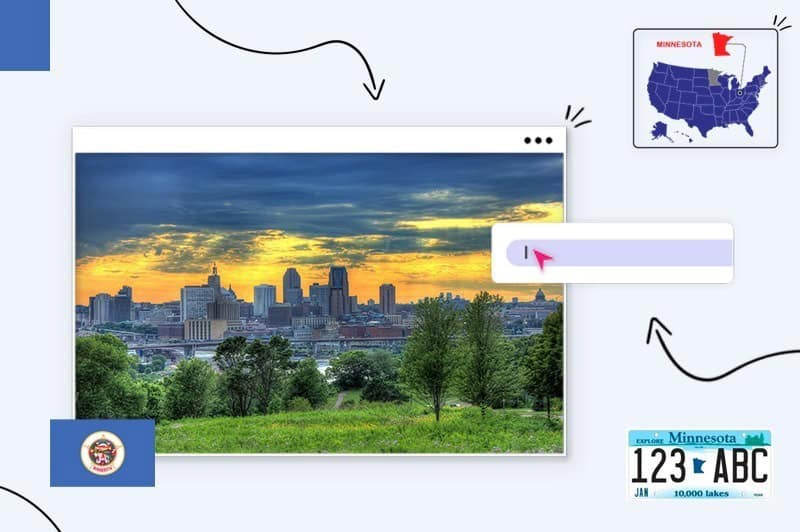
Your next step is choosing an unforgettable, distinctive, easy-to-understand, and pronounceable business name.
You aim to ensure it captures the essence of the products or services you provide while ensuring it ranks in your niche.
For example:
- Branding: Your business name is the cornerstone of your brand identity and should reflect your company’s values, mission, and personality. When choosing, consider what you want your customers to think and feel when they hear or see your name.
- Memorability: A good business name must be easy to remember and pronounce so it stands out and is distinct enough to be searchable online.
- Domain name: Make sure the domain name is available and matches your business name to create a professional website and email address.
Minnesota naming laws and regulations:
Minnesota has particular rules for registering a business name. The first is that no two businesses can have the same or similar names. And when forming an LLC, you must use Limited Liability Company or one of its abbreviations.
Once you’ve chosen a business name, take the following steps:
- Check availability by searching for a business name, on the SOS website.
- Register with the Minnesota Secretary of State, when filing your business entity.
- You can reserve your business name for 12 months by filing a request for reservation of name,.
- Sole proprietorships and partnerships who want to use a name other than their own can file a Certificate of Assumed Name,, also known as a Doing Business As (DBA).
4. Choose a business structure
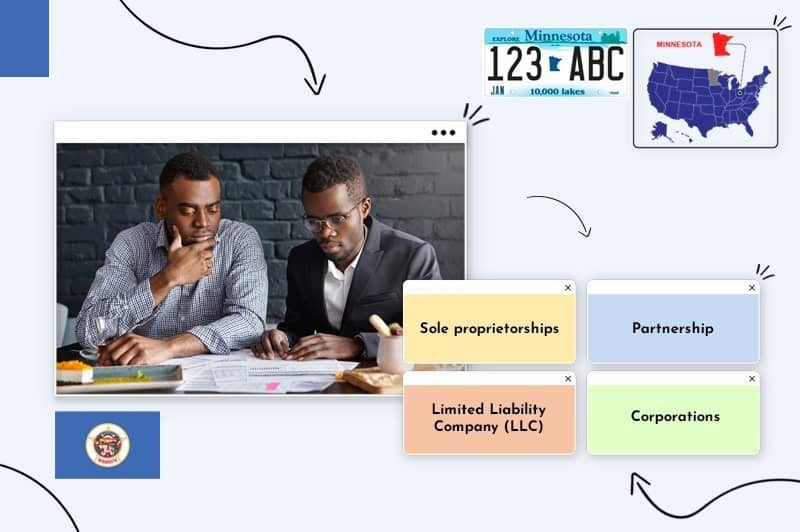
A business structure is a legal framework that determines how you set up and operate your business, pay taxes, your personal liability level, and your ability to raise capital.
The most common business structures for SMBs are a sole proprietorship, partnership (general and limited), limited liability company, and an S corporation.
All come with pros and cons, tax advantages, and suit different business ideas and marketplaces; here’s what you need to know:
The common types of business structure
Sole Proprietorship:
A sole proprietorship isn’t a legal business entity; there’s no separation between you and your business.
Tax-wise, it’s a flow-through tax structure, meaning you receive 100% of the business’s profits and include them on your tax return.
The con is that a sole proprietorship isn’t a separate legal entity, and you’re 100% responsible if your business incurs debt or faces legal action.
General Partnership:
A GP is like a sole proprietorship but with multiple owners. Partners pay income on their tax returns and are liable in litigation cases and debts.
Limited Partnership:
An LP is a legal entity and a separate business structure from its owners, known as members, who enjoy liability protection.
It’s also a flow-through tax structure, with each partner reporting their income on the tax returns.
Limited Liability Company (LLC):
An LLC (Limited Liability Company) combines the asset protection of a corporation with the flexibility of a partnership or sole proprietorship.
Members report their earnings on their tax returns and have complete liability protection.
S Corporation:
An S-corp is an independent legal entity owned by shareholders. S-corps are popular because they provide liability protection, use the flow-through tax structure, and offer tax advantages.
We’ll look at those next:
Tax advantages of each option
- Sole Proprietorship: Sole proprietors report their business income and losses on their tax returns, removing the hassle of filing a separate business tax return.
- Partnership: Like a sole proprietorship, partners report their business income and losses on their tax returns.
- Limited Liability Company (LLC): By default, an LLC is a pass-through entity, which means owners report the business’s income on their tax returns. However, an LLC can also pay tax as a corporation if it suits its financial situation.
- Corporation: There are two main tax benefits for shareholders. They can draw a wage, and the business pays 50% of their income tax and receives further tax-free payments called dividends.
It’s important to note that the tax advantages of each business structure can vary depending on a variety of factors, such as the size of your business, your income level, and your personal financial goals.
How to register a business in Minnesota
To register a separate business entity like an LLC or LP, take the following steps:
- Name your business.
- Choose a registered agent.
- File with the Minnesota Secretary of State.
- Get an EIN on the IRS website.
- Create your operating agreement.
- Get necessary licenses and permits.
- Register for state, income, and self-employment taxes.
- Set up a business bank account.
Once you’ve completed these steps, you can start a business in Minnesota.
5. Set up banking, credit cards, & accounting
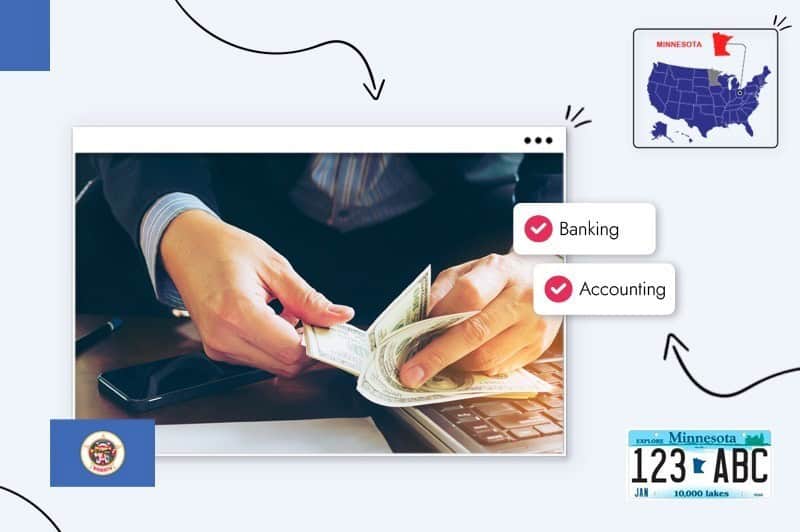
No matter the type of business you form, you’ll need a separate business account to make tracking your income and expenses more manageable.
And if you’re forming an LLC, LP, or corporation, a separate bank account is essential for not “breaking the corporate veil” and maintaining liability protection.
There are other benefits to business banking, credit cards, and accountants, so let’s look:
Business banking:
A separate business bank account helps you maintain accurate financial records, reconcile your monthly statements, and track your cash flow.
It’s also necessary for tax, as you’ll need to report separate business income and expenses.
Credit cards:
A business credit card helps you manage cash flow and separate personal and business expenses.
It can also provide a credit lifeline when business is slow and builds your credit history, which helps you raise capital at a lower interest rate.
Accounting:
SMB owners often need an accountant’s help with state and city taxes, annual tax returns, and payroll taxes.
But you can reduce costs using accounting software that integrates with your bank and credit card accounts to handle your daily bookkeeping tasks. The software lets you track payments, send and view outstanding invoices, and ensure your accounts are in order.
6. Get funding for your Minnesota business
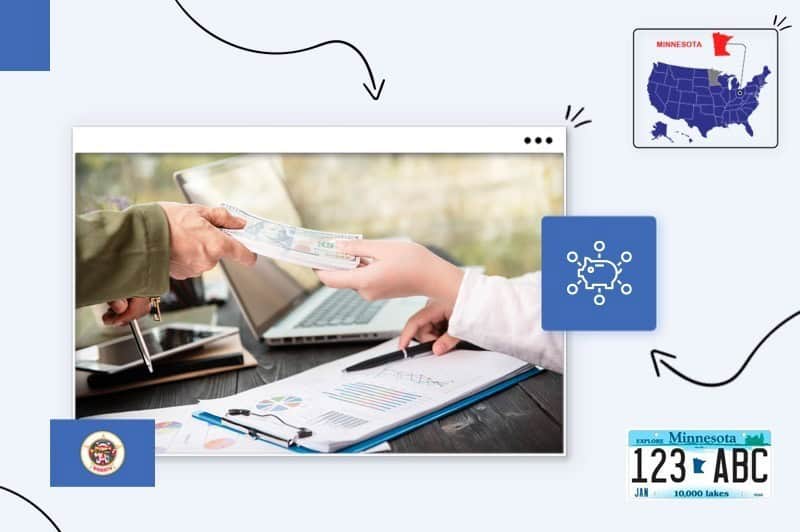
Most new business owners need funding, but only some know their options or how to get it at a favorable interest rate.
So, before you apply for a loan, do this first:
- Create a detailed financial plan to help potential investors or lenders understand your vision, target market, and financial projections.
- Build a good credit score and maintain a positive credit history to qualify for better loan terms and interest rates.
- Calculate your business costs and explore your options before seeking outside funding because then you can choose a lender that suits your business’s needs.
Your funding options include:
Small Business Administration (SBA):
The SBA helps you get an SBA-approved business loan from lending institutions throughout the US. Loans come in different forms to suit individual business needs, such as:
- SBA 7(a) Loan in Minnesota:: Long-term, low-interest loans up to $5 million for equipment, working capital, and real estate.
- SBA 504 Loan in Minnesota: 10 to 20-year low-interest loans for fixed assets, heavy equipment, and real estate.
For more information about SBA loans, visit the Minnesota Employment and Economic Development and the SBA.gov websites.
Minnesota credit union network:
The MCUN is the umbrella branch of all Minnesota credit unions, which provide fixed, variable low-interest small businesses loans, commercial mortgages, credit cards, and credit lines.
Minnesota-specific grants and other loan options:
- Small Business Investment Company Program: Provides financing to new and expanding businesses for job creation and worker retention.
- Minnesota rural business development grant: Business development grants for rural businesses committed to generating local jobs and improving the economy.
- Southern Minnesota Initiative Foundation Economic Impact Grant: Businesses grant up to $20,000 for SMBs to improve the Southern Minnesota region’s infrastructure and economic prosperity.
How to find grants:
Grants are moving targets, with dates and deadlines forever changing. Fortunately, you can track what’s available on these sites:
- Minnesota Small Business Grants: A comprehensive list of Minnesota government grants.
- Minnesota Department of Administration: Provides state grant opportunity updates.
- Department of Employment and Economic Development: Grant programs to help businesses with training expenses.
- Minnesota Department of Agriculture: A complete list of grants, loans, and other funding for businesses in the agricultural sector.
- Minnesota Grantwatch: Provides statistical information on Minnesota grants and approval assessments.
7. Get insured
Starting a small business comes with risks; insurance is how you mitigate them and protect your business from unexpected expenses.
Insurance also provides peace of mind and helps you recover from various losses, including property damage, liability claims, and employee injuries.
Common types of business insurance:
- General liability insurance: Protects against claims of property damage or bodily injury caused by your business operations.
- Property insurance: Covers damage or loss to your business property and assets, including buildings, equipment, and inventory.
- Professional liability insurance: Provides coverage for businesses that offer professional services, protecting against claims of errors, negligence, or malpractice.
- Business interruption insurance: Provides coverage for lost income and expenses if your business cannot operate because of illness or a natural disaster.
Minnesota state-specific insurance regulations:
The Lone-Star state requires some businesses to have specific insurance policies to operate.
For instance:
- Employers require workers’ compensation and unemployment insurance.
- Businesses in high-risk industries like construction need liability insurance.
8. Get permits & licenses

Starting a business in Minnesota requires various permits and licenses to comply with state and local regulations. The ones you’ll need depend on your business type and location.
For example, restaurants require a food service and health permit and an occupation permit for a home-based business.
- Find what licenses and permits your business needs on the Minnesota ELicensing web portal.
- Apply for permits and licenses online through the Minnesota Electronic Licensing System (MELS).
Federal income tax and Minnesota local tax
Besides state taxes, Minnesota businesses may also be subject to local taxes, and almost all must pay self-employment and income tax to the IRS.
Local taxes vary depending on location, but some taxes, licenses, and permits are mandatory throughout Minnesota, including:
- A business selling products or services must register for a Sales and Use Tax account and apply for a Minnesota Tax ID Number from the Minnesota Department of Revenue.
- Business owners with employees must register for workers’ compensation and unemployment insurance with the Minnesota Department of Labor and Industry and get an employer identification number (EIN) from the IRS.
You register with the Minnesota Department of Revenue for corporate income, sales, and employment taxes. For permits, licenses, and local taxes, you register with local tax authorities.
9. Find your team
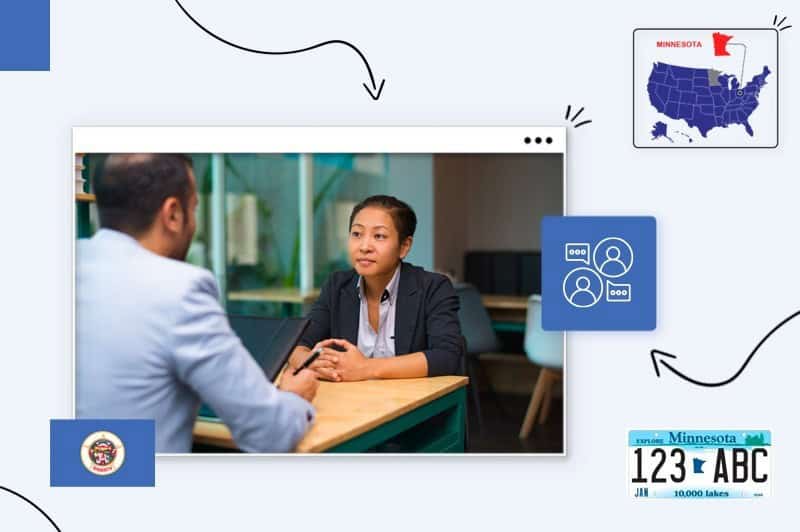
Your team is the face and heart of your business; they build your products, provide your services, communicate with customers, and operate your business.
So, choosing the right people is pretty damn important.
But the onboarding process can be daunting for new business owners, who must also comply with Minnesota laws regarding payroll and hiring.
These tips simplify the hiring process:
- Know why you’re hiring and define the roles to create job descriptions that outline the employee’s responsibilities.
- Look for candidates with the skills, experience, and personality that suit your business. It’s not all about the resume; it’s about attitude.
- Conduct background checks and contact references.
- Have candidates perform relevant tasks to assess their proficiency.
- Use an onboarding process that includes orientation, training, and clear job performance expectations.
People are the backbone of the business
When you start a new business, learn from others; otherwise, you might learn from your mistakes!
Here’s where hiring an experienced local accountant on retainer or networking with existing business owners to learn from their experiences can help your business.
As it grows, hire employees who bring a wealth of skills, knowledge, and fresh perspectives and use contractors to fulfill roles beyond your and your team’s experience.
Comply with Minnesota payroll regulations
Minnesota has state-specific hiring and payroll laws and regulations that your business must adhere to.
For example:
- Small employers grossing less than $500,000 per year must pay a minimum of $8.42 per hour.
- Employers must pay employees wages on a scheduled payday once every 31 days.
- Pay employee commissions at least once every 3 months.
Before hiring employees, you must get a Minnesota Tax ID number and register with the Minnesota Unemployment Insurance Program.
Hire contractors
You don’t have to run your business alone; contractors can help.
And it’s more cost-effective than hiring employees because you avoid payroll taxes and employee insurance. Plus, you can hire on a project basis.
Note:
Minnesota requires you to create a contract outlining the work, scheduling dates, and payment terms before hiring a contractor to avoid disputes.
10. Market & grow your business

Marketing involves promoting your business, building brand awareness, attracting consumers, and turning them into loyal customers.
It begins with a hook, such as helpful content, special offers, or associating your brand with one your target audience trusts.
And continues by encouraging reviews, building a loyal community, and having them sell your business for you.
Here’s how it works:
Invite customers to opt into a mailing list or newsletter
Mailing lists and newsletters are a marketing strategy that encourages people to opt in and receive emails from your business.
In time, your opt-in mailing list or newsletter establishes a community that knows and trusts your brand.
Consider making special offers to attract your first customers
Offering discounts or special promotions encourages your target audience to break their shopping habits and try your products or services.
Look for local businesses or brands to collaborate with
Teaming with other businesses and cross-promoting each other’s products or services can help reach a broader audience.
For example:
My solicitor collaborates with a real estate agency and a home security company. All work with home buyers, offer different services and benefit from each other’s recommendations.
How to find collaborators:
- Networking events: Find local businesses on MeetUp, or visit your local council to inquire about business communities in your area.
- Online forums and communities: Engage with relevant business communities on Facebook and other online forum platforms.
- LinkedIn: Meet other local business owners and grow your network.
Invest in word of mouth (happy customers attract each other)
Word-of-mouth marketing is when your customers tell other people about your brand.
It’s a powerful form of marketing because it’s real people making recommendations, which attracts new customers without investing in advertising.
You encourage WOM by providing exceptional customer service, quality products, and incentives, such as “recommend a friend and get 20% off your next purchase.”
Pay attention to online reviews; ask happy customers to review you.
When did you last buy an online product or visit a new restaurant without reading the reviews?
You don’t do it often, right?
That’s why you must encourage customers to review your business across all your marketing platforms.
Create unique, helpful content to showcase your activity.
Another marketing strategy that provides long-term results is providing free, valuable content to your target audience, like informative podcasts, stunning images, engaging blogs, and instructional videos.
You do this to create trust with your ideal clients before driving them to your sales platforms.
How to find the right content strategy:
- Identify the content your audience engages with by researching your competitor’s social media platforms and websites.
- Set content targets that meet your consumer needs.
- Review your brand’s online presence to ensure it suits your target audience.
- Steal content ideas from leading authority figures in your marketplace.
- Use a publishing content calendar.
- Get active and communicate with any community feedback.
11. Open the doors!
“Opening your business doors” through a physical shopfront or a virtual e-commerce platform has two purposes.
- It introduces your business to your target audience.
- It acts as a “soft opening” that enables you to test the waters, gather customer feedback, and identify any issues you need to resolve.
Whether physical or virtual, your “opening the doors” strategy must create a buzz that gets people talking about your brand, and you do that by throwing a launching event:
Plan a successful launch event
You only get one chance to make a great first impression, so take full advantage of your launch event and create a buzz of excitement among your target audience that gets them talking about your brand.
Tips on planning a launch event:
- Choose a date and location convenient for your target audience.
- Ensure you have any necessary permits and licenses to host the event.
- Create a guest list and send out invitations well in advance.
- Plan activities and entertainment that reflect your brand and message.
- Offer special promotions or discounts.
- Promote it using social media and local advertising platforms.
- Have a photographer or videographer capture the highlights.
- Follow up with guests to thank them for coming and gather feedback.
Remember, your launch event is your opportunity to showcase your brand and make a positive first impression. Do it right, and you might make your first sale!
Land your first sale
Landing your first sale is significant because it proves you’re doing something right and your target audience values what you’re offering.
It also provides valuable feedback on your product or service and helps you learn what resonates with your target audience.
So don’t underestimate the power of your first sale. It’s a crucial step on your entrepreneurial journey.
Conclusion
Those are the steps for how to start a business in Minnesota; all you’ve got to do now is take them.
Remember to follow them in order, apply for available grants, get the proper permits, and partner with other SMB owners to increase your brand awareness and expand your target audience.
And soon, you could be enjoying that famous Minnesota work-life balance!
With these steps completed, it’s time to open your doors, but in case you missed anything, check out these FAQs on how to start a business in Minnesota.
FAQ
Depending on your chosen entity, the fee to incorporate a business in Minnesota varies from $100 to $155. Corporations must pay an annual 9.8% franchise tax.
The cost of forming an LLC in Minnesota is $155.
Minnesota’s mix of a diverse economy, talented workforce, supportive business community, and high quality of life make it a great place to start a business.
Minnesota doesn’t implement a general business license. But most start-ups need permits; some industries require a state business license, and others require federal ones.
You can find what permits and licenses your business needs on the Minnesota ELicensing web portal
Yes, the agent must have a physical address in Minnesota and be available during regular business hours.
